Siemens Healthineers Bundle
How did Siemens Healthineers Evolve into a Healthcare Giant?
From telegraphs to cutting-edge medical technology, the story of Siemens Healthineers is a remarkable journey of innovation. This global leader in the Siemens Healthineers SWOT Analysis has reshaped the healthcare industry, but how did it all begin? Uncover the pivotal moments that transformed a 19th-century electrical engineering firm into a medical technology powerhouse.
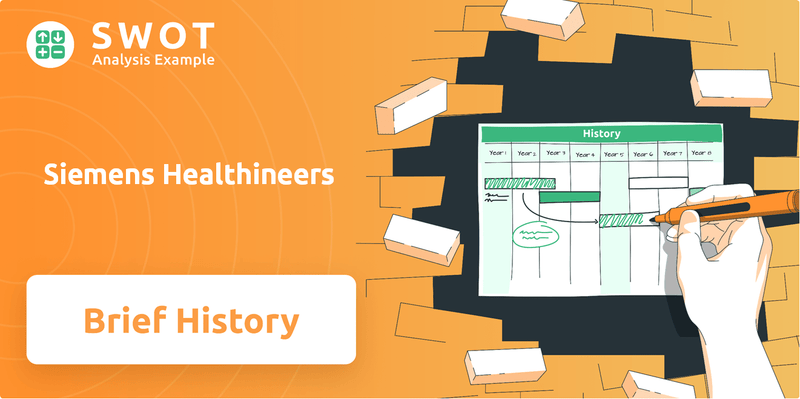
Delving into the Healthineers history reveals a company built on a foundation of electrical engineering, which seamlessly transitioned into pioneering breakthroughs in the healthcare industry. The Siemens Healthineers journey, from its roots as Siemens AG to its current status, demonstrates a commitment to innovation and adaptability. Understanding its past is key to appreciating its present-day impact on medical technology and the future of medicine, including Siemens medical advancements.
What is the Siemens Healthineers Founding Story?
The story of Siemens Healthineers begins on October 12, 1847. On this day, Werner von Siemens and Johann Georg Halske established Telegraphen-Bauanstalt von Siemens & Halske in Berlin, Germany. This marked the inception of what would eventually become a global leader in medical technology.
Werner von Siemens, a visionary inventor, saw potential in improving telegraphy. His invention of the pointer telegraph, which used a needle to indicate letters, was a key innovation. The company initially focused on creating telegraph installations and other electrical equipment, setting the stage for its future diversification.
An early example of Siemens' innovative spirit was Werner Siemens using his Volta Inductor to treat his brother's toothache in 1844. The Slide Inductor for electrotherapy became one of the first medical devices manufactured by Siemens & Halske. The initial funding for the company came from an angel investor, providing 6,842 Taler. The company started with a small team of ten employees in a backyard workshop. Werner von Siemens, then 30 years old, was confident in the revolutionary potential of his new technology, stating in 1847, 'Until now, there has been no company of this kind ever.' This early focus on electrical engineering and a pioneering spirit laid the groundwork for Siemens' eventual expansion into medical technology.
The company's roots are firmly planted in electrical engineering, with an early focus on telegraphy. This foundation paved the way for future innovations in medical technology. The initial funding and small team highlight the humble beginnings of a global powerhouse.
- Founded on October 12, 1847, in Berlin, Germany.
- Initial focus on telegraph installations and electrical equipment.
- Werner von Siemens' invention of the pointer telegraph was a key innovation.
- Early medical device: Slide Inductor for electrotherapy.
Siemens Healthineers SWOT Analysis
- Complete SWOT Breakdown
- Fully Customizable
- Editable in Excel & Word
- Professional Formatting
- Investor-Ready Format
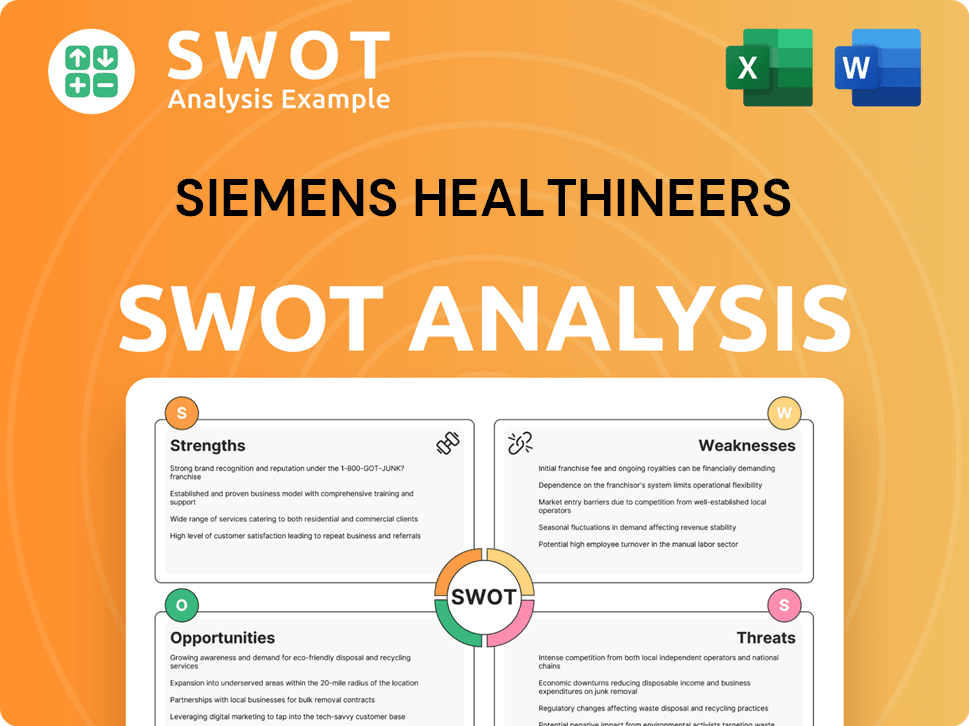
What Drove the Early Growth of Siemens Healthineers?
The early growth of Siemens Healthineers, formerly part of Siemens AG, showcases a remarkable evolution from its initial focus on telegraphy to becoming a leader in medical technology. This expansion was marked by strategic ventures into various fields of electrical engineering. A significant milestone was the development of the first industrially manufactured X-ray tubes in 1896, a pivotal step that laid the groundwork for its future in the healthcare industry.
Siemens' entry into the medical field was solidified with the creation of X-ray tubes, a groundbreaking innovation. This move positioned the company at the forefront of medical diagnostics. The introduction of rotating anode tubes for X-rays in 1933 further advanced modern X-ray technology, enhancing its capabilities.
The formation of Siemens-Reiniger-Werke (SRW) in 1932 through mergers with Veifa-Werke and Reiniger, Gebbert & Schall (RGS) strengthened its foothold in medical technology. This consolidation expanded its product offerings and market reach. These strategic moves were crucial in shaping the company's trajectory within the healthcare industry.
The medical technology division became Siemens Healthcare GmbH on May 1, 2015, and was rebranded as 'Siemens Healthineers' in May 2016. This rebranding reflected its dedication to advancing healthcare through innovative technologies. The company's focus included driving profitable growth and expanding into new markets.
In fiscal year 2017, Siemens Healthineers generated €13.8 billion in revenue, with over 55% from recurring revenue. The company aimed for 4-6% organic revenue growth in the medium term, demonstrating a strong commitment to financial performance. To learn more about the company's target market, read this article: Target Market of Siemens Healthineers.
Siemens Healthineers PESTLE Analysis
- Covers All 6 PESTLE Categories
- No Research Needed – Save Hours of Work
- Built by Experts, Trusted by Consultants
- Instant Download, Ready to Use
- 100% Editable, Fully Customizable
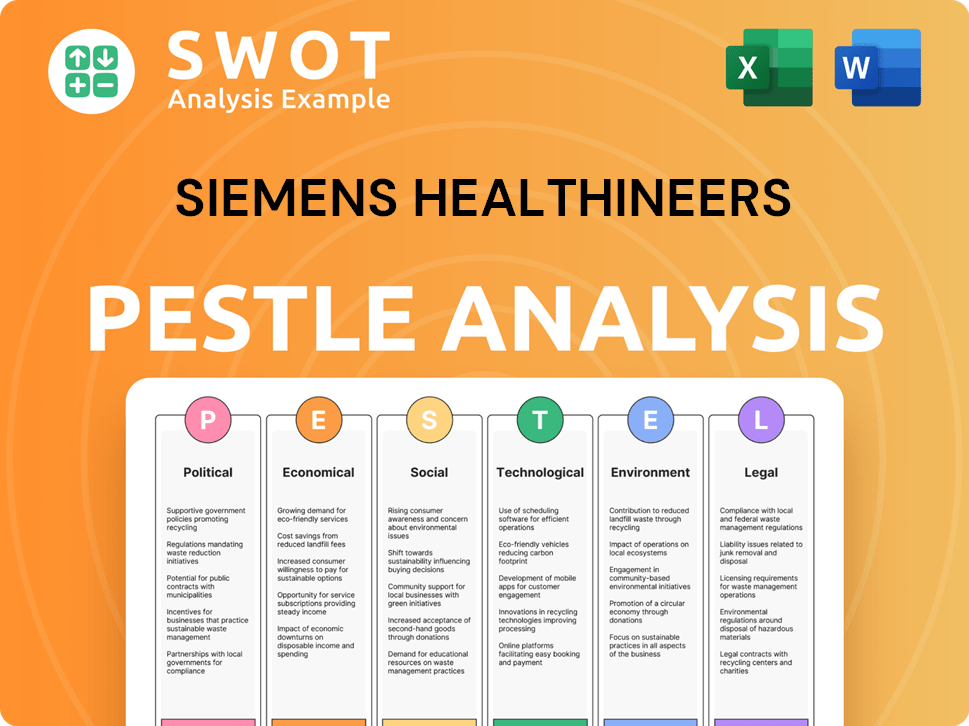
What are the key Milestones in Siemens Healthineers history?
The journey of Siemens Healthineers, a prominent player in the healthcare industry, is marked by significant milestones, starting with its entry into the medical field in 1896. This Healthineers history reflects a legacy of innovation and strategic adaptation within the broader context of Siemens AG.
| Year | Milestone |
|---|---|
| 1896 | Development of the first industrially manufactured X-ray tubes, marking the company's entry into the healthcare industry. |
| 1933 | Introduction of rotating anode tubes for X-rays, enhancing the durability and performance of X-ray technology. |
| 1955 | Introduction of the first fully transistorized X-ray unit, representing a significant advancement in medical technology. |
| 2020 | Acquisition of Varian Medical Systems, expanding the portfolio to include advanced oncology treatments. |
| December 2024 | Acquisition of Advanced Accelerator Applications Molecular Imaging, strengthening its position in theranostics. |
| February 2025 | Collaboration with Vivolight Medical to launch a DSA-OCT Integrated Multi-Modal Diagnostic and Treatment Platform. |
Siemens Healthineers has consistently pushed the boundaries of medical technology through continuous innovation. The company's commitment to research and development is evident in its allocation of 9% of its revenue, which totaled €1.918 billion in 2024, to R&D expenses.
The integration of Artificial Intelligence in image reconstruction and automated analysis has improved diagnostic accuracy and efficiency.
Development of photon-counting CT systems has enhanced image quality and diagnostic capabilities.
Despite its achievements, Siemens Healthineers has faced challenges, including market pressures and increased competition within the healthcare industry. The Diagnostics segment, for example, has experienced profitability issues, leading to restructuring efforts.
The company faced challenges due to weaker demand from the Chinese market, impacting overall revenue growth.
Increased competition in the rapidly evolving healthcare sector has presented challenges for market share and profitability.
The Diagnostics segment has faced profitability issues, leading to restructuring efforts and a focus on its flagship platform.
Integrating acquired companies, such as Varian Medical Systems, has presented complex challenges in terms of operational and cultural alignment.
Global economic conditions, including inflation and supply chain disruptions, have impacted operational costs and market dynamics.
Navigating complex regulatory landscapes and ensuring compliance with evolving healthcare standards pose ongoing challenges.
For a deeper dive into the financial aspects of the company, including its revenue streams and business model, you can explore Revenue Streams & Business Model of Siemens Healthineers. Despite these hurdles, Siemens Healthineers demonstrated resilience, with a revenue increase of approximately 6% to €5.48 billion in Q1 fiscal year 2025.
Siemens Healthineers Business Model Canvas
- Complete 9-Block Business Model Canvas
- Effortlessly Communicate Your Business Strategy
- Investor-Ready BMC Format
- 100% Editable and Customizable
- Clear and Structured Layout
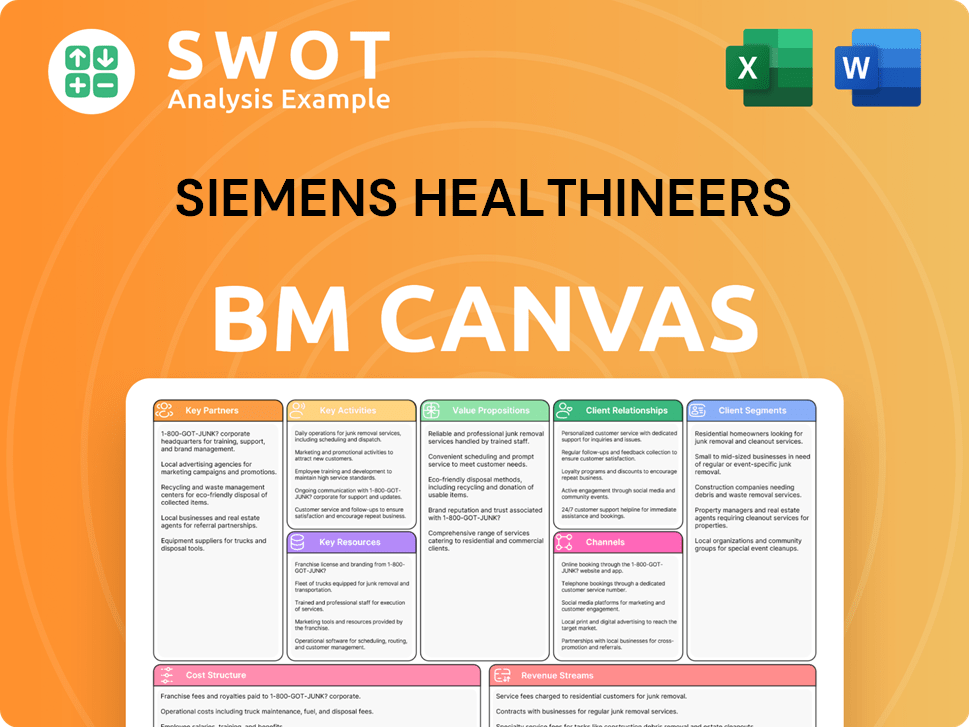
What is the Timeline of Key Events for Siemens Healthineers?
The Healthineers history is a story of continuous innovation and strategic evolution, marked by pivotal moments that have shaped its trajectory in the healthcare industry. From its origins in 1847 as Telegraphen-Bauanstalt von Siemens & Halske to its current standing as a leading medical technology company, Siemens Healthineers has consistently pushed the boundaries of what's possible in healthcare. The company's journey includes significant milestones such as the development of X-ray tubes in 1896, the introduction of the first fully transistorized X-ray unit in 1955, and the strategic acquisitions of companies like Varian Medical Systems in 2020. Each step reflects its commitment to advancing medical technology and improving patient care. For a deeper understanding of the competitive environment, explore the Competitors Landscape of Siemens Healthineers.
| Year | Key Event |
|---|---|
| 1847 | Werner von Siemens and Johann Georg Halske found Telegraphen-Bauanstalt von Siemens & Halske in Berlin. |
| 1896 | Siemens enters the healthcare industry with the development of X-ray tubes. |
| 1932 | Siemens-Reiniger-Werke (SRW) is formed through mergers, consolidating Siemens' medical technology business. |
| 1955 | Siemens introduces the first fully transistorized X-ray unit. |
| 2001 | The name Siemens Medical Solutions is adopted. |
| 2008 | The company is rebranded as Siemens Healthcare. |
| 2015 | Siemens Healthcare GmbH is founded as an independent company. |
| 2016 | The business operations are rebranded 'Siemens Healthineers.' |
| 2017 | Siemens Healthineers is spun off from Siemens AG, with Siemens AG retaining a 75% stake. |
| 2018 | Siemens Healthineers goes public with an initial public offering on the Frankfurt Stock Exchange. |
| 2020 | Siemens Healthineers acquires Varian Medical Systems, significantly expanding its cancer care solutions. |
| 2021 | Promoted to the DAX, Germany's most important stock market index. |
| December 2024 | Completes the acquisition of Advanced Accelerator Applications Molecular Imaging from Novartis. |
| February 2025 | Reports a Q1 fiscal year 2025 revenue increase of approximately 6%, reaching €5.48 billion. |
| March 2025 | Receives FDA clearance for Naeotom Alpha Class of Photon-Counting Computed Tomography Scanners. |
| April 2025 | Enters a 10-year value partnership with Tower Health to advance precision imaging and patient care. |
Siemens Healthineers anticipates comparable revenue growth between 5% and 6% for fiscal year 2025. Adjusted basic earnings per share are projected to be between €2.35 and €2.50. The company is focused on maintaining its growth trajectory by adapting to market changes and customer needs.
Key strategic initiatives include continued investment in innovation, with a focus on areas like 'patient twinning,' 'precision therapy,' and 'digital, data, and artificial intelligence (AI).' The company aims to improve market leadership beyond 2025 through structural cost savings and productivity improvements.
Siemens Healthineers anticipates global demand for imaging equipment and services to grow in the mid-single digits over the next decade. This growth is expected to be driven by demographic shifts and expanding healthcare access worldwide. The company's focus remains on pioneering breakthroughs in healthcare.
The company's commitment to innovation and its founding vision of leveraging technology for societal benefit remains central to its future direction. This includes a dedication to research and development, ensuring it remains at the forefront of medical technology advancements.
Siemens Healthineers Porter's Five Forces Analysis
- Covers All 5 Competitive Forces in Detail
- Structured for Consultants, Students, and Founders
- 100% Editable in Microsoft Word & Excel
- Instant Digital Download – Use Immediately
- Compatible with Mac & PC – Fully Unlocked
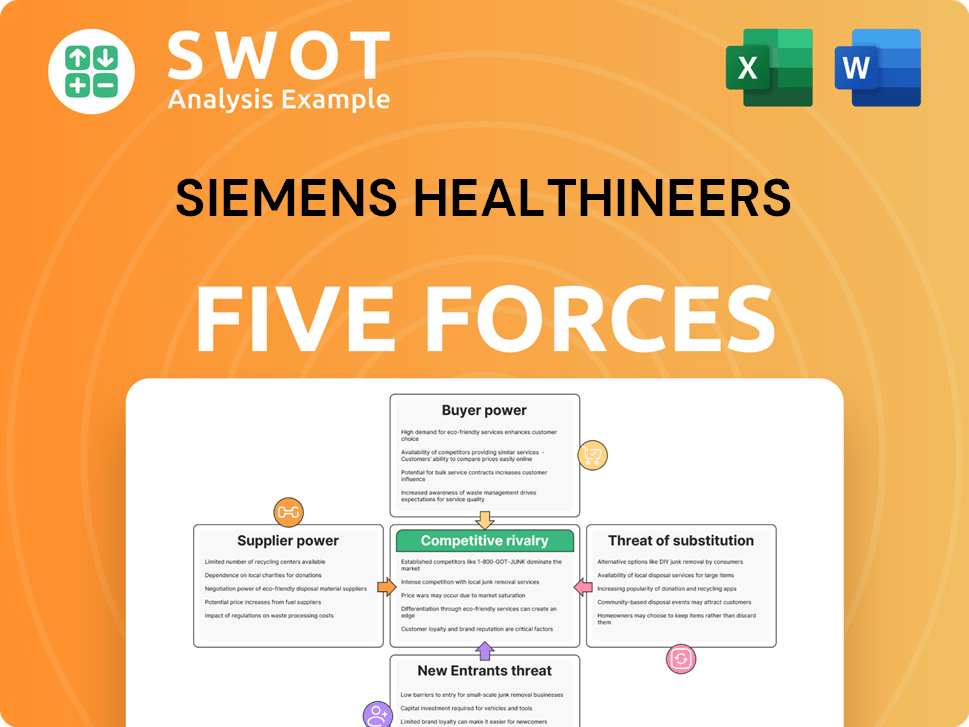
Related Blogs
- What is Competitive Landscape of Siemens Healthineers Company?
- What is Growth Strategy and Future Prospects of Siemens Healthineers Company?
- How Does Siemens Healthineers Company Work?
- What is Sales and Marketing Strategy of Siemens Healthineers Company?
- What is Brief History of Siemens Healthineers Company?
- Who Owns Siemens Healthineers Company?
- What is Customer Demographics and Target Market of Siemens Healthineers Company?
Disclaimer
All information, articles, and product details provided on this website are for general informational and educational purposes only. We do not claim any ownership over, nor do we intend to infringe upon, any trademarks, copyrights, logos, brand names, or other intellectual property mentioned or depicted on this site. Such intellectual property remains the property of its respective owners, and any references here are made solely for identification or informational purposes, without implying any affiliation, endorsement, or partnership.
We make no representations or warranties, express or implied, regarding the accuracy, completeness, or suitability of any content or products presented. Nothing on this website should be construed as legal, tax, investment, financial, medical, or other professional advice. In addition, no part of this site—including articles or product references—constitutes a solicitation, recommendation, endorsement, advertisement, or offer to buy or sell any securities, franchises, or other financial instruments, particularly in jurisdictions where such activity would be unlawful.
All content is of a general nature and may not address the specific circumstances of any individual or entity. It is not a substitute for professional advice or services. Any actions you take based on the information provided here are strictly at your own risk. You accept full responsibility for any decisions or outcomes arising from your use of this website and agree to release us from any liability in connection with your use of, or reliance upon, the content or products found herein.